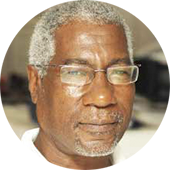
WHEREVER he would’ve been today, Sir Arthur Lewis would certainly have been smiling broadly, possibly from ear to ear, even also giving a thumb-up – or ‘Both Two’, as some of his countrymen would say, for added local emphasis!
Why? For at least the following five reasons…
One: Because the CARICOM Reparations Commission (CRC) has finally determined an amount owed by Britain and other European nations to Caribbean nations as Reparations for centuries of Slavery and Native Genocide in the so-called West Indies.
Sir Arthur, 81 years ago, penned the only Blueprint for Caribbean Reparations from Britain, in which he made the case for the British West Indies to be freed and paid Reparations.
In his seminal book ‘Labor in the West Indies (1939)’ after he toured the islands to observe what he described therein as the 1938 ‘Revolutions’.
Sir Arthur, then already making waves as the youngest and brightest Black West Indian academic on the UK university circuit, made the clearest economic case for Reparations.
However, the young sage refrained from specifying amounts, instead outlining a formula through a blueprint that could serve as a template, over time.
Two: Because eight decades later, on Emancipation Day August 1, 2020, CARICOM governments agreed to adopt his blueprint for discussions with Britain and other European nations that built empires on the backs of African slaves in the Caribbean.
CRC Chairman Sir Hilary Beckles revealed in an interview on October 11 that the Caribbean needs at least US $50 billion in Reparations from European nations for centuries of Slavery and Unpaid Labour.
That money, he said, will not go to national treasuries or individuals, but into a proposed International Development Fund to be regionally and internationally managed to guarantee delivery to the ultimate intended beneficiaries, the Caribbean’s people.
The initial funds can be donated by entities that profited from Slavery and have so far apologised for their role; and their atonement contributions would be used to begin a genuine Caribbean growth process.
The proposed Fund will provide capital outlay for much-needed productive projects across the Caribbean to advance people’s social, cultural and economic development.
The CRC Chair said contributing to the fund would be ‘a good start’ by the many UK and European companies that have now belatedly admitted gains from Slavery-funded start-up of their initial operations centuries ago, all of which remain profitable today on the basis of seed financing from the enslavement of Africans in the Caribbean.
“Every bank on the high streets of England, all the banks that you know — Lloyds, Barclays, National Westminster, Midlands — all began their journey in the financing of slavery and colonization; and they have all issued apologies,” Professor Beckles said.
The interview, by Professor Andy Knight, was held as part of activities across the region encouraging commemoration of International Day for Reparations on October 12 every year, instead of ‘Columbus Day’.
Three: Because the Reparations message he subscribed to and prescribed will be introduced to his homeland, in his people’s native tongue, as part of observances of Kweyol (Creole) Heritage Month (October), by the best person to so do.
Dame Pearlette Louisy, one of Sir Arthur’s foremost literary heirs, will deliver the island’s first-ever Kweyol Reparations Lecture on October 22, entitled: Jistis wanvoyé sé jistis wifizé: Wépawasyon pou lèsklavaj èk jennosid an sé péyi Kawaib-la (Justice delayed is justice denied: The case for reparations for slavery and native genocide in the Caribbean).
Saint Lucia’s longest-serving Governor General (1997-2018), Dame Pearlette was one of the Founders of a group called ‘Mokweyol’, which, with the Folk Research Center (FRC), pioneered the movement towards demanding official recognition of Kweyol as Saint Lucia’s indigenous language.
Mokweyol and FRC also published a Kweyol-language bulletin called ‘Balata’.
At the time, though Kweyol was spoken by the majority, it was outlawed in schools and official or business circles – until, as Governor General, Dame Pearlette started delivering substantial parts of her annual Throne Speech in Parliament in Kweyol.
Jounen Kweyol (Kweyol Day) has been observed annually, for decades, on the Sunday closest to October 25 (observed globally as International Creole Day); and as the biggest national annual non-holiday cultural event here over the years, also led to October being designated ‘Kweyol Heritage Month’.
Four: Because Dame Pearlette was Principal of the Sir Arthur Lewis Community College (SALCC) before becoming Head of State; and she’ll be delivering her lecture as Chair of the National Nobel Laureates Festival Committee that annually celebrates Sir Arthur and Saint Lucia’s second Nobel prizewinner, Hon. Derek Walcott; and
Five: Because of the two lectures series being undertaken here by the National Reparations Committee (NRC).
The Dame’s October 22 lecture is part of a national year-long series being sponsored by the NRC in cooperation with the UWI Open Campus and with backing from the SALCC.
However, the NRC is also sponsoring a year-long regional series on another important topic of growing Caribbean and global interest — the Caribbean’s Indigenous People, for whom the CRC is also seeking Reparations.
The UWI’s Center for Reparations Research (CRR), which observed its 3rd Anniversary on October 12, is coordinating and executing the NRC’s Regional Schools Reparations Lectures out of Jamaica.
Launched last month by CRC Director Professor Verene Shepherd, the regional series continues on October 29 with a double-presentation on ‘The Myth of Extinction: Indigenous Peoples & Their Survival Strategies’ by President of the Garifuna Nation of Belize Egbert Higinio and Dominican historian Lennox Honeychurch.
The two series highlight local observances of International Creole Day and support CRC’s and CRR’s promotion of October 12 as a day to remember the region’s Indigenous peoples.
So yes, Sir Arthur would’ve had all those reasons – and more — to smile broadly today, the first day of the next eight months before the 30th anniversary of the day he started his final trip along the long and winding River of No Return.












